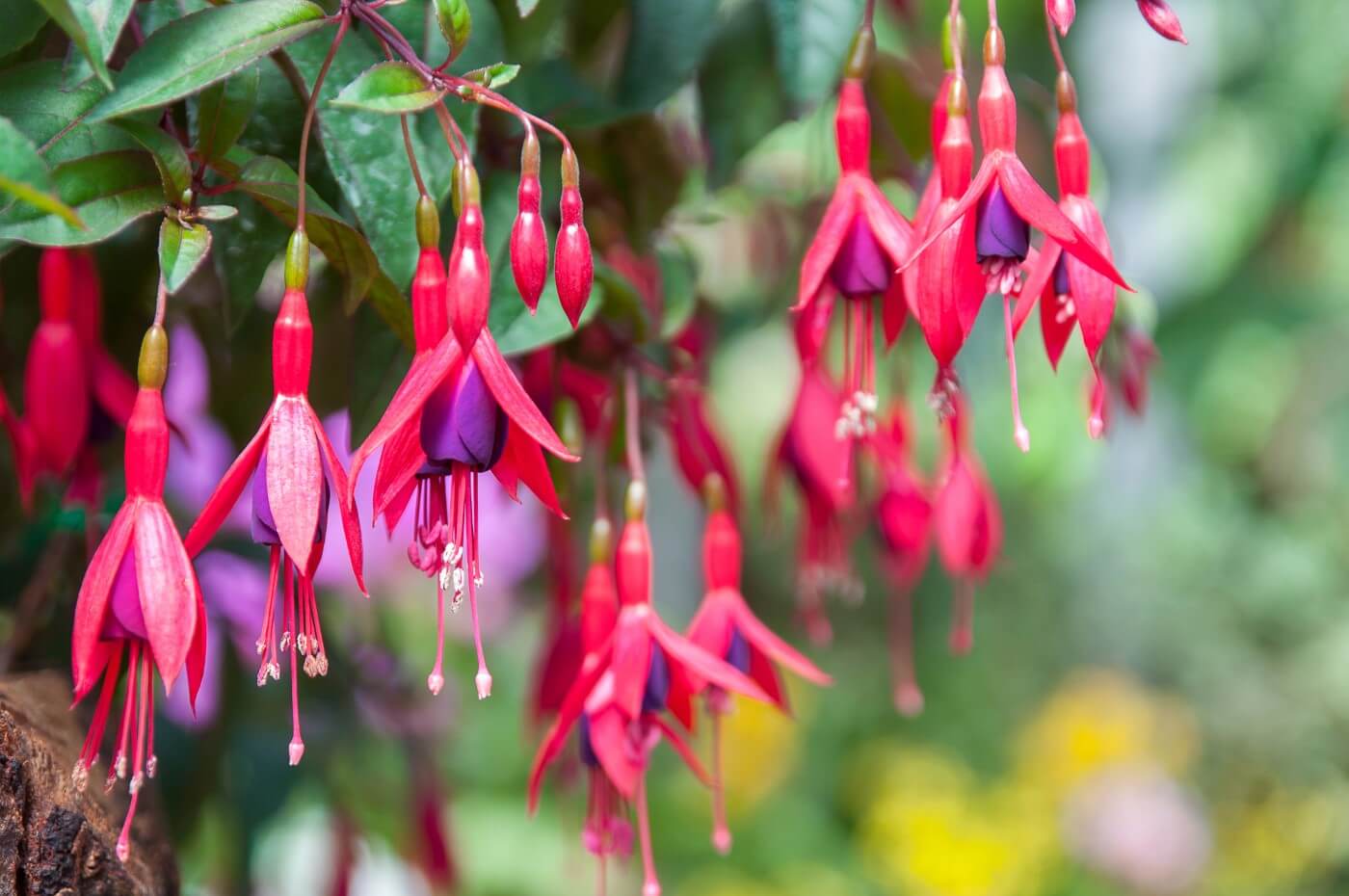
Are you looking to dive into the fascinating world of plants? If so, let me introduce you to the stunning and captivating Fuchsia. Known for its vibrant and showy flowers, Fuchsia is a genus that encompasses around 110 different species. Native to Central and South America, as well as New Zealand and Tahiti, Fuchsia has become a beloved plant around the world for its unique charm.
In this article, we will delve into 17 captivating facts about Fuchsia that will leave you amazed and intrigued. From its long history and cultural significance to its intriguing biology and extraordinary variety, Fuchsia has much to offer. So, let’s embark on this journey together and discover the many wonders of this enchanting plant.
Key Takeaways:
- Fuchsia, named after a botanist, comes in vibrant colors, attracts hummingbirds, and symbolizes elegance. It’s easy to grow, but watch out for aphids and enjoy its sweet fragrance.
- Fuchsia, native to Central and South America, has medicinal uses and can be grown indoors. It was popular in the Victorian era and is celebrated in festivals worldwide.
Fuchsia is named after the German botanist Leonhart Fuchs.
Fuchsia, the vibrant and enchanting flowering plant, gets its name from Leonhart Fuchs, a renowned 16th-century German botanist. His contributions to the field of botany were immense, and the plant was named as a tribute to his valuable work.
Fuchsia flowers come in a wide range of stunning colors.
One of the captivating features of fuchsia is its incredible array of colors. From vibrant purples and pinks to striking reds and whites, fuchsia flowers add a pop of color to any garden or landscape.
Fuchsia plants are native to Central and South America.
The genus Fuchsia is native to Central and South America, particularly regions like Brazil and Argentina. These regions provide the ideal conditions for fuchsias to flourish, with their tropical and subtropical climates.
Fuchsia flowers are known for their unique shape.
The distinctive shape of fuchsia flowers sets them apart from other flowering plants. They usually consist of a slender, elongated tube-like structure with delicate petals that flare outwards, creating a beautiful and eye-catching display.
Fuchsia flowers attract hummingbirds.
Hummingbirds are drawn to the nectar-rich flowers of fuchsia plants. The tubular shape of the flowers and their vibrant colors make them irresistible to these tiny and agile birds, adding another element of fascination to fuchsias.
Fuchsia plants are excellent choices for hanging baskets.
The trailing growth habit of fuchsia plants makes them perfect candidates for hanging baskets. Their cascading branches filled with colorful blooms create a stunning display when suspended from porches, balconies, or pergolas.
There are thousands of cultivars of fuchsia.
From single-flowered to double-flowered varieties, upright or trailing growth habits, and different color combinations, there is an astonishing array of fuchsia cultivars. With thousands of options to choose from, fuchsia enthusiasts can find a perfect fit for their preferences.
Fuchsia plants require well-drained soil.
Proper soil drainage is essential for fuchsia plants’ health and vitality. These plants prefer moist but well-drained soil to prevent waterlogging, which can lead to root rot and other diseases.
Fuchsia flowers can be used to make natural dyes.
The vibrant colors of fuchsia flowers can be extracted and used to create natural dyes for fabrics and other materials. This ancient practice adds an interesting dimension to the historical uses of fuchsia.
Fuchsia plants are prone to aphid infestations.
Aphids, small sap-sucking insects, are common pests that can affect fuchsia plants. Regular inspection and control measures, such as natural predators or organic insecticides, are necessary to keep these pests at bay.
Fuchsia flowers have a delicate, sweet fragrance.
Alongside their visual appeal, fuchsia flowers also emit a delicate and sweet aroma. This fragrance adds another sensory dimension to the experience of growing and appreciating fuchsias.
Fuchsia plants can be propagated from cuttings.
One of the fascinating aspects of fuchsia cultivation is that these plants can be easily propagated from cuttings. Stem cuttings of fuchsias have a high success rate, making it an accessible and rewarding method for gardeners.
Fuchsia plants have medicinal uses.
In traditional medicine, different parts of the fuchsia plant have been used to treat various ailments. From skin conditions to digestive issues, fuchsia has been incorporated into herbal remedies by different cultures throughout history.
Fuchsia flowers symbolize elegance and grace.
The symbolism attached to fuchsia flowers often represents qualities such as elegance, grace, and femininity. The vibrant colors and unique shape of the flowers evoke a sense of beauty and sophistication.
Fuchsia plants can be grown indoors as houseplants.
With the right conditions, fuchsia plants can thrive indoors as houseplants. Providing adequate light, humidity, and regular care will enable garden enthusiasts to enjoy the beauty of fuchsia indoors as well.
Fuchsia festivals celebrate the beauty of these captivating flowers.
Many regions around the world hold fuchsia festivals to celebrate the beauty and diversity of these enchanting flowers. These festivals often feature stunning displays, competitions, and educational events for fuchsia enthusiasts.
The Victorian era saw a surge in fuchsia popularity.
During the Victorian era, fuchsia plants became wildly popular as ornamental plants. The Victorians embraced the intricate beauty of fuchsia flowers and introduced many new varieties through hybridization.
Conclusion
Fuchsias are truly fascinating plants that captivate both gardeners and nature enthusiasts alike. With their vibrant and diverse range of colors, unique flower structure, and ability to thrive in various climates, fuchsias have become a popular choice for gardens and landscapes around the world. Whether you’re a seasoned gardener or just starting out, adding fuchsias to your collection will surely bring joy and beauty to your outdoor space.
From their history as exotic wildflowers to their cultivation and hybridization, there is so much to discover and appreciate about fuchsias. Their versatility as both container and garden plants make them an excellent choice for any garden design. With proper care and attention, these plants will reward you with their stunning blooms year after year.
So, why not embark on a fuchsia-filled adventure and explore the world of these captivating plants? You won’t be disappointed!
FAQs
1. Can fuchsias tolerate cold weather?
While fuchsias generally prefer mild climates, some varieties are more cold-tolerant than others. It’s best to choose hardy fuchsia cultivars if you live in a colder region to ensure their survival through the winter.
2. How often should I water my fuchsia plants?
Fuchsias prefer consistently moist soil. It’s important to water them regularly, especially during hot and dry periods. However, be careful not to overwater, as this can lead to root rot. It’s always best to check the soil’s moisture level before watering.
3. Can I grow fuchsias indoors?
Yes, you can grow fuchsias indoors as long as they receive sufficient light. They thrive in bright, indirect sunlight, so place them near a well-lit window. Indoor fuchsias may require more frequent watering due to the dry indoor air.
4. How do I prune my fuchsia plants?
Pruning is important for maintaining the shape and health of your fuchsia plants. It’s recommended to prune in late winter or early spring before new growth emerges. Remove any dead or damaged branches, as well as any crossing or overcrowded branches. This will promote better airflow and encourage more plentiful blooms.
5. Can I propagate fuchsias from cuttings?
Yes, fuchsias are easily propagated from cuttings. Take softwood cuttings in spring or early summer and place them in a well-draining potting mix. Keep the cuttings in a warm, humid location until roots develop. Once rooted, you can transplant them into individual pots or directly into the garden.
Fuchsia's captivating beauty extends beyond the facts we've explored here. Delve deeper into the world of these stunning flowers by learning about the hardy and versatile Fuchsia magellanica, uncovering even more surprising facts about Fuchsia, and discovering the best tools to keep your garden looking its best.
Was this page helpful?
Our commitment to delivering trustworthy and engaging content is at the heart of what we do. Each fact on our site is contributed by real users like you, bringing a wealth of diverse insights and information. To ensure the highest standards of accuracy and reliability, our dedicated editors meticulously review each submission. This process guarantees that the facts we share are not only fascinating but also credible. Trust in our commitment to quality and authenticity as you explore and learn with us.


